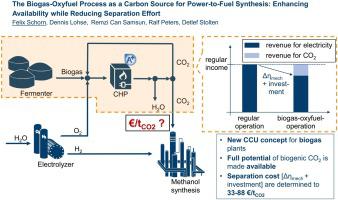Journal of CO2 Utilization ( IF 7.2 ) Pub Date : 2021-01-06 , DOI: 10.1016/j.jcou.2020.101410 Felix Schorn , Dennis Lohse , Remzi Can Samsun , Ralf Peters , Detlef Stolten

|
Producing synthetic fuels via Power-to-Fuel processes requires hydrogen and a carbon source. To attain a sustainable fuel, both reactants must originate from a renewable source. For the carbon source, biogas plants offer substantial potential. Hence, this paper presents a new biogas-oxyfuel process that couples a biogas plant with Power-to-Fuel production and enables a decentralized and economical supply of biogenic carbon dioxide for the production of renewable methanol. By using the oxygen byproduct of the Power-to-Fuel synthesis in the oxyfuel combustion of a combined heat and power unit, a simple separation of the CO2 in the flue gas is made possible. To analyze the thermodynamic changes within the combustion engine when switching from regular to oxyfuel combustion, an AspenPlus model of the combined heat and power unit of a biogas plant is built up herein. Due to the higher heat capacity of the new working gas carbon dioxide in comparison to nitrogen, the ideal Otto engine cycle’s mechanical efficiency drops by percentage point. This drop in efficiency leads to a loss in revenue for the operator of the biogas plant. Together with the additional equipment expenditures for the CO2 separation, this loss is defined as the CO2 separation costs. For a retrofit of existing biogas plants with an installed electric power of 75−1000 kW, the CO2 separation costs are determined to be 88−33 €/t. The process shown therefore offers a promising way to deliver biogenic CO2 at low cost for decentralized Power-to-Fuel systems.
中文翻译:

沼气-氧燃料工艺作为动力合成燃料的碳源:在减少分离工作量的同时提高可用性
通过电力制燃料工艺生产合成燃料需要氢和碳源。为了获得可持续的燃料,两种反应物都必须来自可再生资源。对于碳源,沼气厂具有巨大的潜力。因此,本文提出了一种新的沼气-含氧燃料工艺,该工艺将沼气厂与电力生产相结合,并能够分散,经济地供应生物二氧化碳以生产可再生甲醇。通过在热电联产装置的富氧燃烧中使用“燃料合成”的氧气副产物,可轻松分离出CO 2在烟气中成为可能。为了分析当从常规燃烧转换为含氧燃料燃烧时内燃机中的热力学变化,本文建立了沼气厂热电联产装置的AspenPlus模型。由于新的工作气体二氧化碳比氮气具有更高的热容量,因此理想的奥托发动机循环的机械效率降低了百分点。效率下降导致沼气厂运营商的收入减少。连同用于CO 2分离的额外设备支出一起,将该损失定义为CO 2分离成本。对于现有装机功率为75-1000 kW的沼气厂的改造,确定的CO 2分离成本为88-33€/ t。因此,所示过程为分散式电力燃料系统提供了以低成本输送生物CO 2的有前途的方法。










































 京公网安备 11010802027423号
京公网安备 11010802027423号